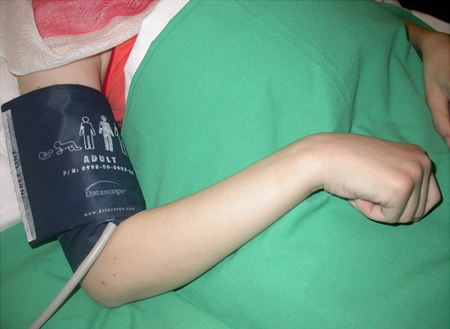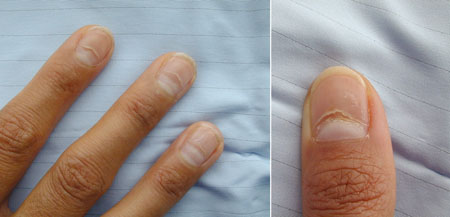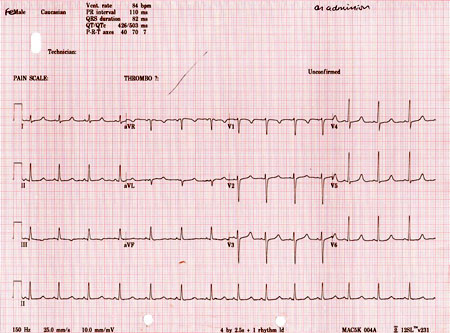Approach
Historical and exam findings often narrow the differential diagnosis considerably. The initial tests to order in a patient presenting with hypocalcemia are serum total calcium concentration, albumin, magnesium, renal function, and serum intact parathyroid hormone level.[1]
History
The age at which hypocalcemia and hypocalcemic symptoms and signs manifest is important. If hypocalcemia occurs at an early age, congenital etiologies should be investigated. If it occurs in an older person living in a nursing home, where there may be little access to sunshine, then vitamin D deficiency is a likely cause.
A history of neck surgery points toward possible causes of hypocalcemia. Patients undergoing thyroidectomy may have parathyroid glands accidentally removed, damaged, or devascularized. Another cause of hypocalcemia after surgery is "hungry bone" syndrome, which usually occurs during the first 2 postoperative days of parathyroid adenoma surgery. These patients need massive replacement of calcium and magnesium.
Fatigue, muscle weakness, cramps, and pain may suggest vitamin D deficiency.
Abdominal pain with signs of hypocalcemia suggests the possibility of acute pancreatitis.
Medication history could alert to iatrogenic causes of hypocalcemia. These include the use of proton-pump inhibitors, bisphosphonates, denosumab, chemotherapy, chelating agents, glucocorticoids, anticonvulsants, or cinacalcet.[12][23][24][25][29]
Chronic complaints of numbness and tingling in the fingertips, toes, and perioral region can indicate hypocalcemia.
Family history of hypocalcemia should be investigated.
Patients taking immunosuppressive drugs and/or with a history of skin cancer will become vitamin D deficient if they follow rigorous sun avoidance advice. People who routinely use high SPF sunscreen, have dark skin and live in northern latitudes, wear concealing clothing, are chronically housebound, or have fat-soluble vitamin malabsorption, are at risk of severe vitamin D deficiency. Factors including male sex, abnormal body mass index, non-white ethnic background, smoking, and socioeconomic deprivation have also been associated with increased risk for vitamin D deficiency.[31]
Presence of chronic diarrhea with steatorrhea and intestinal disease, such as Crohn disease or chronic pancreatitis, may suggest hypocalcemia due to malabsorption of calcium or vitamin D.
Malnutrition or chronic illness may result in decreasing circulating albumin, which is a common cause of hypocalcemia.
A history of repeated blood transfusions for chronic anemia, or defects of iron metabolism (e.g., hemochromatosis) or copper metabolism (e.g., Wilson disease), and less commonly a current malignancy, could suggest an infiltrative process in the parathyroid glands.[8][9]
Physical exam
Patients with hypocalcemia may have no physical signs.
Trousseau sign may be apparent. This is a carpopedal spasm in response to ischemia that occurs when a blood pressure cuff is used for several minutes. [Figure caption and citation for the preceding image starts]: Carpopedal spasm (Trousseau sign) occurred a few minutes after inflation of a sphygmomanometer cuff above systolic blood pressurePedrazzini B et al. BMJ Case Reports 2010;2010:bcr.08.2009.2188 [Citation ends].

Carpopedal spasm that occurs in alkalosis (e.g., due to hyperventilation) may occur in patients with hypocalcemia. This is a painful spasm of the hands and feet that could be a presenting sign, particularly in patients with a history of panic attacks/hyperventilation.
Arrhythmias may manifest as an irregular heart beat on exam.
Healed surgical scar at the base of the neck could indicate thyroid surgery that might have caused parathyroid gland loss or damage.
Chvostek sign (brief contraction/twitching of perioral muscles, resulting in contraction of the corner of the mouth, ipsilateral nasal musculature, and ipsilateral eye musculature) may be elicited by tapping over cranial nerve VII at the ear. Chvostek sign is neither sensitive nor specific for hypocalcemia.[3]
Seizure disorder or muscle cramps related to tetany are presenting signs in patients with severe hypocalcemia.
Kyphoscoliosis in an older patient could indicate osteoporosis secondary to chronic vitamin D deficiency or osteomalacia.
Neurologic manifestations such as irritability, extrapyramidal symptoms, personality disorder, choreoathetosis, and dystonia could be signs of neurologic manifestation of cerebellar or basal ganglia calcification.[32]
A short fourth metacarpal bone (brachydactyly) is an important sign of pseudohypoparathyroidism.[14]
Subcapsular cataracts can indicate chronic hypocalcemia.[4]
Optic disc edema can occur in severe cases of hypocalcemia. It may or may not be associated with increased intracranial pressure.[33]
Skin is dry, coarse, and puffy in patients with chronic hypocalcemia. Hyperpigmentation and eczema can also occur in rare cases. Nail changes may occur. [Figure caption and citation for the preceding image starts]: Nail dystrophy due to hypocalcemiaNijjer S et al. BMJ Case Reports 2010;2010:bcr.08.2009.2216 [Citation ends].

Patients with congenital abnormalities may present with highly variable features, ranging from mild learning disabilities to the complete spectrum of congenital malformations (such as the classic triad of cardiac anomalies, hypoplastic thymus, and hypocalcemia seen in DiGeorge syndrome) and other aspects of velopharyngeal insufficiency (e.g., cleft palate).
Laboratory evaluation
Initial tests include serum total calcium concentration, albumin, and magnesium; renal function; and serum intact parathyroid hormone level.
Other investigations commonly include serum levels of ionized calcium, bicarbonate, alkaline phosphatase, phosphorus, and 25-hydroxyvitamin D; and 24-hour urine calcium and creatinine.[34]
Serum total calcium levels, adjusted for albumin, should be the first test performed in patients presenting with symptoms and signs of hypocalcemia.
Serum albumin concentration should be tested, as over 40% of circulating calcium is bound to albumin in a ratio of 0.8 mg calcium to 1 mg albumin. This ratio is conventionally used to adjust the total calcium after measuring albumin. The formula for adjusted serum calcium is:
(0.8 × [normal albumin - patient’s albumin]) + serum calcium.
However, the formula is superseded when ionized calcium is measured (if available). The formula for adjusted calcium may not be reliable in all circumstances (such as in critically ill patients).
Serum magnesium should be measured where hypomagnesemia is suspected. Hypomagnesemia or severe hypermagnesemia can cause hypocalcemia and may indicate the underlying etiology. Any cause of hypomagnesemia (e.g., use of proton-pump inhibitors [PPIs]) can result in hypocalcemia.[12][29] It is important to identify hypomagnesemia, because calcium cannot be adequately adjusted unless magnesium has first been replaced. Hypomagnesemia secondary to PPI use can only be adjusted by stopping the PPI.
Renal function: elevated urea and creatinine can indicate renal dysfunction.
Intact parathyroid hormone (PTH) levels should be tested in every patient with hypocalcemia. PTH levels will be low in overt hypoparathyroidism (e.g., iatrogenic or infiltrative damage, congenital absence) and are elevated in vitamin D deficiency, renal disease, and in malignancies with skeletal metastases.
25-hydroxyvitamin D levels should be measured in patients suspected of having vitamin D deficiency. Serum alkaline phosphatase may also be useful in these patients (where levels may be elevated). Alkaline phosphatase is elevated in patients with skeletal metastases.
Serum chemistries including (ionized) calcium, bicarbonate, alkaline phosphatase, and phosphorus should be obtained: high levels of phosphate in the absence of renal failure and tissue breakdown indicate hypoparathyroidism or pseudohypoparathyroidism.
Amylase and/or lipase levels should be checked in patients with abdominal pain. In acute pancreatitis the amylase and lipase levels are significantly increased.[35] Use serum lipase testing in preference to serum amylase.[36]
Serum creatinine, creatine kinase, magnesium, and phosphorus levels are particularly relevant tests in patients suspected of having rhabdomyolysis and cell lysis syndrome.
T-cell counts are useful in suspected DiGeorge syndrome where a T-cell lymphopenia is commonly seen. Fluorescence in situ hybridization analyses can confirm 22q11.2 deletion.
ECG should be performed to evaluate arrhythmias and prolonged QT intervals. Hypocalcemia prolongs phase II action potential, leading to prolonged QT intervals, which may be the only electrocardiographic sign of hypocalcemia. [Figure caption and citation for the preceding image starts]: Electrocardiogram (ECG) showing an adjusted QT interval (QTc) of 503 ms while in sinus rhythmNijjer S et al. BMJ Case Reports 2010;2010:bcr.08.2009.2216 [Citation ends].

Imaging studies
X-rays should be performed when multiple fractures or signs of osteomalacia are observed.
Isotope bone scans should be performed for patients with possible malignant metastasis.
Use of this content is subject to our disclaimer